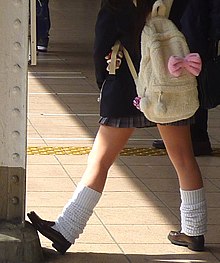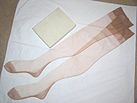Loose sock

Loose socks (ルーズソックス, rūzu sokkusu) are a style of baggy sock popular with Japanese high school girls.[1][failed verification]
They were adopted as a fashion which flattered plump calves and also expressed rebellious deviation from Japan's strict dress code for school uniforms.[2][page needed] They were first worn by high school girls and later by junior high school girls who sought to emulate the look of the older female students, but are generally not worn by young adults and older women.[citation needed]
They are nearly always white, though black and navy blue ones also exist. Generally, they are larger than normal socks. To wear them, one stretches them out and puts them on. They are usually worn below the knee, held up with a special adhesive sock glue, and resemble leg warmers. Loose socks are often paired with skirts above the knee and a pair of mary janes or loafers.[citation needed]
Birth and establishment
At the beginning of the 1990s, it became fashionable for Japanese high school girls to shorten their skirts. In the mid-90s, they wore imported mountain-climbing boot socks to make their legs look thin and attractive.[3][failed verification] These socks were manufactured by such sock makers as America's E.G. Smith. It is not known if there was a time when loose socks were called "boot socks", but they quickly became referred to as "loose socks" and, together with miniskirts, became an established fashion.[citation needed]
The two most well-known views are that the fashion originated in Sendai, Miyagi or in Mito, Ibaraki. In both stories, to protect against the cold, girls bought, loosened, and wore large socks. It is said that they became popular because they made fat legs look thin. After that, the socks became established merchandise and spread to major cities such as Tokyo and Osaka, and then throughout the whole country. They rapidly gained popularity, chiefly with high school girls.[citation needed]
The height of loose socks' popularity was from 1996 to 1998. Furthermore, in that period varieties such as "super loose" and "gom nuki loose" (loose socks with the elastic removed) were born. There were even socks two meters long. These were mainly worn by the yamanba gal subculture. Some schools forbade pupils to wear loose socks at school, so girls would often change into loose socks and wear them outside the school campus. This sort of trend was picked up on by the mass media, which brought attention to loose socks as emblematic items of high school girl culture.[citation needed]
References
- ^ Sam Wallace (1998-10-24), "Filling the gap", The Daily Telegraph, London, retrieved 2010-05-11
- ^ Jan Dodd, Simon Richmond, Japan: the rough guide
- ^ Kimiko Akita, "Ch 4. Cuteness", Women and the media


